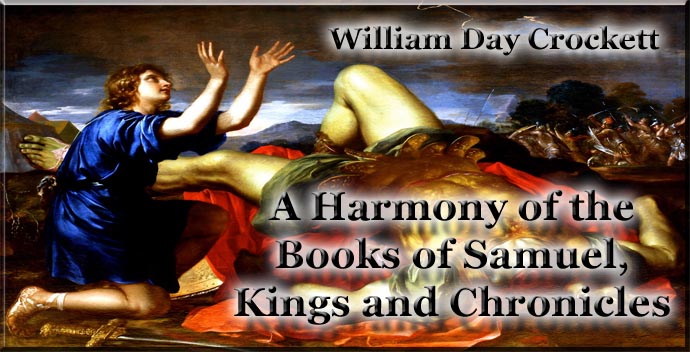
A Harmony of the Books of Samuel, Kings and Chronicles
By William Day Crockett
Introduction
By Professor WILLIS J. BEECHER, D.D.,Of the Theological Seminary of Auburn in the State of New York. I GLADLY accept the invitation to write a few words of introduction to the volume which my friend Mr. Crockett has prepared. Not many words are needed. The plan of the book speaks for itself. In Old Testament study, at present, the thing that most demands investigation is the Old Testament itself. This fact is so obvious as to be accepted by all and under stood by only a very few. By studying the Old Testament itself, some mean the looking up of points therein for illustrating current religious doctrine and experience. Others mean the repeating of the interpretations of the history, as these have been handed down to us from the time of Josephus. Others mean the examination of the new knowledge concerning the Bible derived from travels and surveys and explorations. Yet others understand the mental unraveling of the literary work done by the men who wrote the books of the Old Testament, the analyzing of these into certain real or supposed original documents, with conjectures as to the authorship of the original documents, and the processes by which they were combined until they assumed the form in which we now have them. All these ways of study have their value, but none of them is, properly speaking, the study of the Old Testament as it now exists. The first is the study of certain matters in the Old Testament, and not of the Old Testament itself. One might pursue it for a lifetime without acquiring anything like a connected idea as to either the books or their contents. The second, except indirectly, is not a study of the Old Testament at all. From babyhood we have been familiar with the current superficial understanding of the events recorded; it is time that we turn from this and ask what the Old Testament actually says concerning these events. The third is indissolubly connected with the second. If through our traditional mistakes we misinterpret the statements made in the Scriptures, this will lead us equally to misinterpret what the monuments have to say on the same subjects. And the fourth form of study above mentioned is not a study of the Old Testament, but of the real or supposed sources of the Old Testament. As far as it is based upon an inadequate understanding of the Old Testament as it stands, so far is it necessarily crude and misleading. What we need is something different from these four forms of study, something that is presupposed by each of the four, something that is demanded as the basis of each of the four, namely, the study of the contents and the form of the books of the Old Testament as they stand. When we thoroughly understand the things which the existing Old Testament says, and the literary form in which it says them, we shall be better prepared to analyze our existing Scriptures into their primary component parts, and to understand those parts; and we shall be qualified to perceive the true bearing of the information gained by recent discoveries, to estimate traditional interpretations rightly, to appreciate more fully the religious teachings. It is a thing especially commendable in the work of my friend Mr. Crockett that he has labored in this part of the field, here where labor is needed. He has set him self to understand, and to help others understand, a portion of the contents of the Old Testament itself. In large sections of the volume he has done nothing more than print parallel accounts in parallel columns for ready reference. So far the value is merely mechanical—a mere bit of convenient machinery. This by itself was worth the doing, but he has done far more than this. He has himself attained to a firm grasp upon the history as a whole, and has attempted, by a careful analysis, to show others how to take the same grasp. In traversing three fourths of the path this was relatively simple. It was the remaining fourth, lying in separate sections at half a dozen different points, that taxed his skill and industry and patience. The larger half of the value of his work is that which appears, in comparatively small bulk, in these difficult sections. Of course, not all his results will at once be accepted as final. Every scholar will think him correct to the extent to which he agrees with him, and no further. It is for these best parts of Mr. Crockett's work that fault is most likely to be found with him. The reader will occasionally miss the confusing but familiar landmarks of the Josephan interpretation of the history, and will be ready at once to exclaim that Mr. Crockett has lost his way. In such instances, however, he will do well to take the trouble to understand the offered interpretation before absolutely rejecting it. I have enough confidence in the intelligence and industry of the present generation of students of the Bible to lead me to expect that this volume will have wide acceptance and usefulness. Auburn, New York, June, 1897. |
|
 |
 |
|
Bible References taken from: The World English Bible (WEB) is a Public Domain (no copyright) Modern English translation of the Holy Bible, based on the American Standard Versionof the Holy Bible first published in 1901, the Biblia Hebraica Stutgartensa Old Testament, and the Greek Majority Text New Testament. |
|
-
Site Navigation
 Home
Home What's New
What's New Bible
Bible Photos
Photos Hiking
Hiking E-Books
E-Books Genealogy
Genealogy Profile
Free Plug-ins You May Need
Profile
Free Plug-ins You May Need
 Get Java
Get Java.png) Get Flash
Get Flash Get 7-Zip
Get 7-Zip Get Acrobat Reader
Get Acrobat Reader Get TheWORD
Get TheWORD